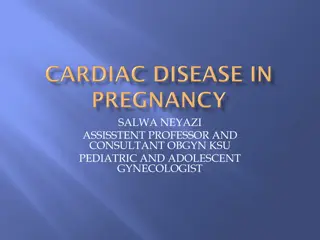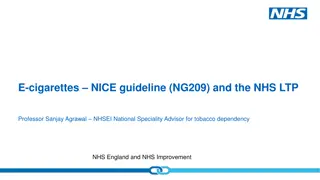Impact of Nicotine Use in Pregnancy: Risks and Consequences
Smoking and nicotine use during pregnancy pose significant risks, including low birth weight, stillbirth, miscarriage, preterm birth, heart defects, and Sudden Infant Death Syndrome. Nicotine Replacement Therapy is licensed for pregnant women but lacks evidence of effectiveness in smoking cessation during pregnancy. The steep social gradient in smoking during pregnancy reflects the challenges in achieving national tobacco control goals, emphasizing the urgent need for interventions and support for pregnant women to quit smoking.
Download Presentation

Please find below an Image/Link to download the presentation.
The content on the website is provided AS IS for your information and personal use only. It may not be sold, licensed, or shared on other websites without obtaining consent from the author. Download presentation by click this link. If you encounter any issues during the download, it is possible that the publisher has removed the file from their server.
E N D
Presentation Transcript
Use of Nicotine in Pregnancy @LindaBauld
Outline Smoking in pregnancy Nicotine Replacement Therapy in pregnancy Nicotine and tobacco harm reduction Cochrane review SNAP Trial Evidence from non randomised studies Ongoing research
Smoking in pregnancy in England Smoking at Time of Delivery 16.0 14.6 14.2 14.0 13.7 13.3 12.9 12.2 12.0 11.7 11.0 10.7 10.1 9.8 10.0 9.5 8.9 Latest national Tobacco Control Plan set a 2022 target of 6% - to reach it will require a near doubling of the current rate of decline nationally 8.9 8.3 8.0 8.0 7.7 7.1 6.0 6 4.0 2.0 0.0 2008/09 2009/10 2010/11 2011/12 2012/13 2013/14 2014/15 2015/16 2016/17 2017/18 2018/19 2019/20 2020/21 2021/22 current rate of progress to reach 2022 target
Impact of smoking in pregnancy Maternal smoking Passive smoking Low birth weight Average 250g lighter Average 30-40g lighter Stillbirth Double the likelihood Increased risk Miscarriage 24%-32% more likely Possible increase Preterm birth 27% more likely Increased risk Heart defects 50% more likely Increased risk Sudden Infant Death 3 times more likely 45% more likely Source: www.smokefreeaction.org.uk/smokefree-nhs/smoking-in-pregnancy-challenge-group/ - draws on systematic reviews initially reported in the Royal College of Physicians report on passive smoking & children (2014), updated Reviews 2018.
Nicotine Replacement Therapy in Pregnancy Licensing changed in 2005 to allow prescriptions for pregnant women and other priority groups (i.e. patients with CVD, children over the age of 12) Widely prescribed including to women accessing stop smoking services across the UK Endorsed in 2010 NICE guidance, although health professionals to use clinical judgement and discuss risks and benefits with women No evidence of effectiveness for smoking cessation in pregnancy (see later in the presentation) increased metabolism a likely explanation, along with limited adherence 7
Some basics: where does nicotine come from? Nicotine is present is several types of plants in the nightshade family. This includes potatoes, aubergine, tomatoes and red peppers It also includes the tobacco plant Nicotine can be produced synthetically, but this is expensive and not commercially viable Nicotine in cigarettes, other tobacco products (including oral tobacco ) and Nicotine Replacement Therapy comes from the tobacco leaf It is both a sedative and a stimulant and affects the heart rate, breathing activity and blood pressure. It may improve memory and concentration Nicotine can be addictive but it depends on the mode of delivery
Guidance on Nicotine The UK has formal guidance on tobacco harm reduction and this guidance has, as its basis, evidence reviews on nicotine primarily in the form of Nicotine Replacement Therapy The reviews conducted for the guidance did not cover pregnancy, but make it clear that there are no circumstances under which it is safer to smoke than to use NRT The guidance endorses the use of NRT for: temporary abstinence, cutting down, smoking cessation and long term use (relapse prevention)
Pregnant smokers are worried about nicotine Qualitative studies with pregnant smokers illustrate real concerns about nicotine separate from smoking These relate to safety, addictiveness, and whether using NRT increases the risk of relapse to smoking UK studies also suggest that advice and support from health professionals regarding nicotine + NRT is inconsistent I can remember the conversation we had about it and [the smoking cessation advisor] was letting me know where I can put [the patches] and what not, but to myself I just thought no, that s just a bit too you know you sit there thinking about it. I don t know, it s weird, I just think it s too close to the baby to be having all that nicotine going in My main concern was obviously smoking passes on horrible chemicals to the child, does this [NRT] still do that Source: Bowker, K et al (2015) Understanding pregnant smokers adherence to nicotine replacement therapy during a quit attempt: a qualitative study. Nicotine & Tobacco Research, 18(5), 906-912.
Cochrane Review: NRT in pregnancy Most recent review of RCTs examined the efficacy and safety of smoking cessation pharmacotherapies in pregnancy. 9 trials of NRT and one of bupropion identified up to July 2015 Overall finding: There were no differences between NRT and control groups in rates of miscarriage, stillbirth, premature birth, birthweight, low birthweight, admissions to neonatal intensive care, caesarean section, congenital abnormalities or neonatal death. Non serious side effects observed with NRT included headache, nausea and local reactions (e.g. skin irritation from patches or foul taste from gum), but these data could not be pooled. Source: Coleman T, Chamberlain C, Davey MA, Cooper SE, Leonardi Bee J (2015) Pharmacological interventions for promoting smoking cessation during pregnancy. Cochrane Database of Systematic Reviews. https://www.cochranelibrary.com/cdsr/doi/10.1002/14651858.CD010078/full
SNAP Trial 1050 Participants 12-24 weeks >5 cigs/day (>10 pre-pregnancy) CO>8ppm Behavioural support & up to 8weeks 15mg/16hr nicotine patch offered Behavioural support & up to 8weeks placebo patch offered Followed up: 1 month & delivery By questionnaire until infants 2 years old Led by Prof Tim Coleman, University of Nottingham. 15mg/16hr patch used. Mean gestational age at recruitment 16 wks 12
SNAP Findings Significant 2.05 (1.46 -2.88) 25 20 % validated cessation Non significant 1.26 (0.82 -1.96) 15 NRT Placebo 10 5 0 One month Delivery Source: Coleman, T., Cooper, S., Thornton, J. G., Grainge, M. J., Watts, K., Britton, J., & Lewis, S. (2012). A randomized trial of nicotine-replacement therapy patches in pregnancy. New England Journal of Medicine, 366(9), 808-818.
Effectiveness of single product NRT for smoking cessation in Pregnancy NRT
SNAP Follow up objectives To compare at 2 years after delivery, the impact of NRT & placebo on: 1. Infant survival without impairment: no disability or problems with development ASQ-3: screening instrument, high sensitivity & specificity. 5 domains: communication, fine and gross motor, problem solving, personal-social. All needed to be normal. 2. Infant respiratory symptoms 3. Maternal prolonged smoking abstinence Source: Cooper, S., Taggar, J., Lewis, S. et al(2014). Effect of nicotine patches in pregnancy on infant and maternal outcomes at 2 years: follow-up from the randomised, double-blind, placebo-controlled SNAP trial. The Lancet Respiratory Medicine, 2(9), 728-737. 15
Responses to parental and health professional questionnaires at 2 years 1,050 randomised NRT 521 Placebo 529 PQ2 304 (57%) 302 (58%) HPQ 148 (28%) 146 (28%) Outcome data Total returned: 452 (85%) Total returned: 448 (86%) Live singleton births: 503 Total returned: 445 (88.5%) Live singleton births: 507 Total returned: 446 (88.0%) 16
Infant outcomes at 2 years Outcomes allocated from PQ2 or HPQ Multiple imputation ITT analysis [singleton live births n=1010] OR (95% CI) NRT Placebo 1.40 Survival with no impairment (primary outcome) 323/445 (73%) 290/443 (65%) (1.05-1.86) (p=0.023) 132/444 (30%) 111/444 (25%) 1.30 Respiratory problems (0.96-1.77) Similar findings for complete case analyses (i.e. just those with returned questionnaires), including those adjusted for clustering by twin births, and in PQ2 only analyses 17
SNAP Follow up: implications 1st trial of smoking cessation intervention in pregnancy to assess infant outcomes at 2 years First time a smoking cessation intervention seen to have beneficial effect on pregnant smokers children Better developmental outcomes of infants in the NRT group due to reduced smoking? 18
Evidence on Safety from non-RCT studies In addition to the Cochrane review and the SNAP trial there is some evidence on safety from non-randomised controlled trials These studies look at key pregnancy and birth outcomes including: Preterm birth Birth weight Small for gestational age Still birth Congenital abnormalities & other outcomes
Evidence on Safety from non-RCT studies Findings from non-RCT studies are consistent with those from the Cochrane review and provide additional detail. They primarily examine women who smoke or use NRT (or both) in pregnancy Overall, for the outcomes mentioned in the last slide, there is a lower rate of negative pregnancy-related health outcomes when NRT is used in pregnancy compared to smoking. In addition, NRT used by smokers is not associated with poor outcomes but smoking alone is, suggesting NRT may have a protective effect One outcome that may be worse in NRT users (with or without smoking) is infant colic. But an improvement in other pregnancy outcomes when NRT is used as an alternative to smoking probably outweigh any risk of colic.
Ongoing research: N-Ready Programme NIHR HTA funded programme led by Professor Tim Coleman at the University of Nottingham Contains a series of work streams including several systematic reviews, one is on the safety of NRT in pregnancy Future trial of higher dose (combination therapy) NRT planned Should provide valuable new evidence on the effectiveness of NRT in pregnancy and inform future updated NICE guidelines
Summary Smoking in pregnancy remains a significant public health challenge that results in adverse outcomes for mothers and children NRT is widely prescribed for smoking cessation in pregnancy in the UK A high quality UK trial adds to international evidence suggesting single product NRT isn t effective for cessation but does not result in harm to infants Non randomised studies also suggest that using NRT in pregnancy is far safer than smoking Ongoing research is underway, but for now the priority remains to support women to stop smoking in pregnancy, including by continuing to use nicotine in less harmful forms than in cigarettes.
Thank You Linda.Bauld@ed.ac.uk @LindaBauld























